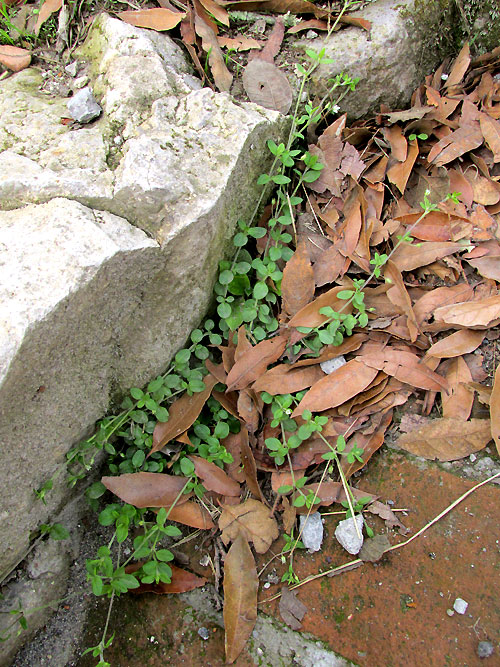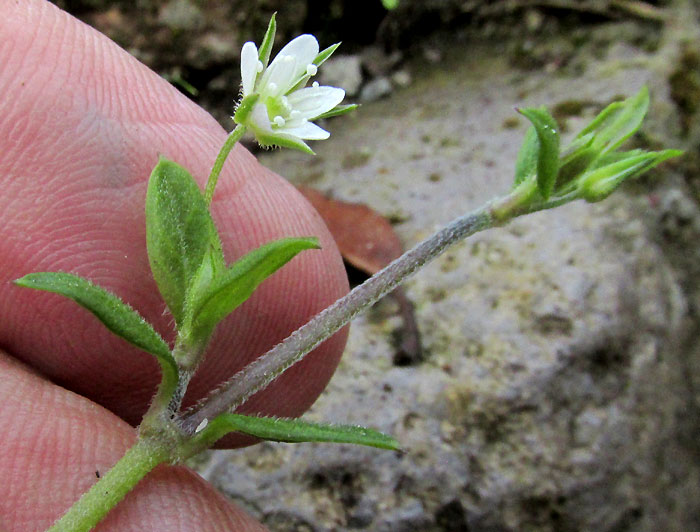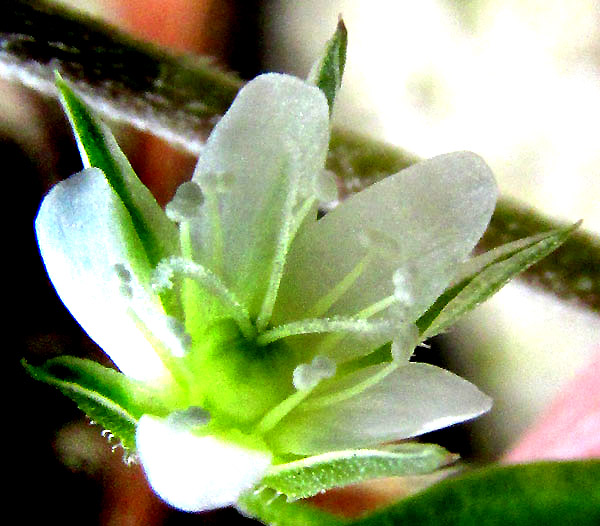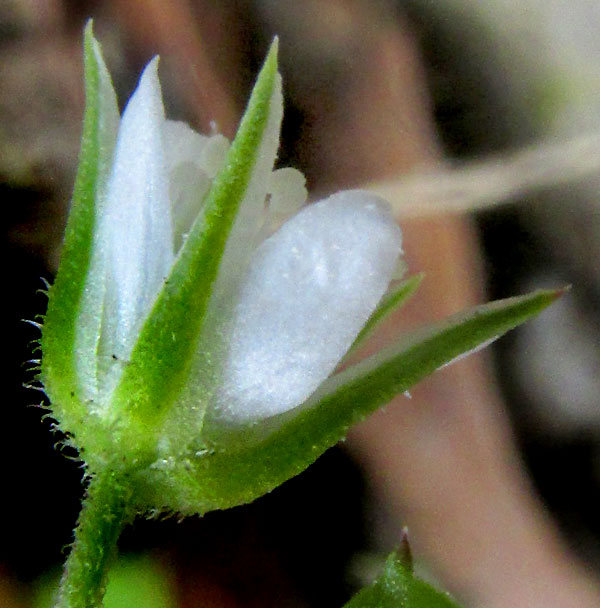Excerpts from Jim Conrad's
Naturalist Newsletter
entry from field notes dated July 29, 2022, taken in an oak forest atop Cerro de la Cruz, elevation ~2885m (~9465 ft), rising on the south side of the community of El Pinar, Amealco de Bonfil, Querétaro, MÉXICO, (~N20.17°, ~W100.17°)
SPREADING SANDWORT

At the very summit of Cerro de la Cruz, where oak leaves had blown up next to the base of the gigantic metal Jesus on the Cross, the above wildflower had rooted in cracks between the statue base's stones and tiles. The plant was similar to the northern lawn weed called Chickweed, and up close the flowers and oppositely arranged leaves were somewhat like that plant's, too:

However, even from that distance it was clear that this wasn't chickweed, if only because the tips of chickweed's white petals are so deeply incised that they make the flowers look like they have 10 petals instead of the 5 on this blossom. Up closer still, other differences were seen:

Note the narrow, green sepals with their pale, papery margins and sharp points extending well beyond the white petals. The three slender styles emerge from the spherical, green ovary without joining at their bases.

Above it's seen that the plant's general hairiness extends onto the flower's pedicel and sepals.
Chickweeds and similar species belong to the Pink Family, the Caryophyllaceae, of which carnations, baby's breath and campions or catchflies are well known members. Embracing around 3000 species worldwide, and especially rich in north-temperate, montane and alpine species, it's not surprising to find a member at such a high elevation.
The above-noted features and others take us to the Pink Family's genus Arenaria, that name based on the Latin arena, meaning sand, where species in the genus often show up. In fact, species of Arenaria often are known as sandworts. Our plant is in a windswept, thin-soiled, rocky situation with no sand, but apparently it's desolate enough to satisfy a certain predisposition.
About 210 Arenaria species are recognized worldwide, though at this time gene sequencing results are reshuffling concepts. The 2013 treatment of Arenaria in the Flora del Bajío, which covers our region, documents 6 species here. Of those six, the only species that's conspicuously hairy and which produces sprawling stems longer than 20cm (8 inches) is the Spreading Sandwort, ARENARIA LANUGINOSA.
The species bears an English name because it occurs in the US Southeast from Virginia to Texas, as well as south to southern South America. Occupying such a large area, it's fractured into several different-looking local geographical populations that in the past were formally named as distinct varieties and subspecies. However, gene sequencing finds no reason to retain the sub-taxa occurring in our area, and currently The World Flora Online lumps them, including the roundish-leafed variety megalantha our plant seems to be -- all under Arenaria lanuginosa. By the way, lanuginosa means "downy."
In our area Spreading Sandwort is described as inhabiting many environments, including oak and coniferous forests, tropical deciduous (mesquite and the like), grassy and disturbed areas, even as a weed in abandoned fields. It's found at elevations from 1400-3200 meters (4600-10,500 feet), which is an impressive range.
Sandwort fruits are plump, thin-walled capsules in which up to 35 tiny seeds may be produced. It's hard to find documented "uses" for this plant, but it's easy to visualize small creatures such as sparrows, finches and rodents contentedly eating the seeds, and if a deer comes along whole stems might quickly be gulped down. Sandworts produce taproots which anchor them in marginal habitats, and slender rhizomes enabling them to snake into narrow places, all the time securing the soil in place with their filiform rootlets.
By the way, the Pink Family is pink not because its flowers are pink, though some are, but because in many of its species the flowers' petals are incised like the chickweed's, forming Y shapes, as if they were "pinked" with pinking shears, "pink" being used in the verbal sense.